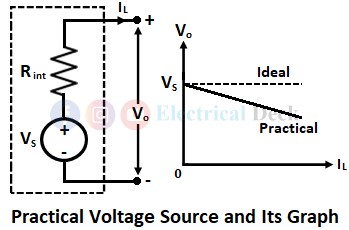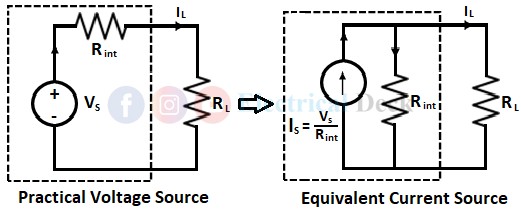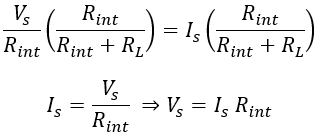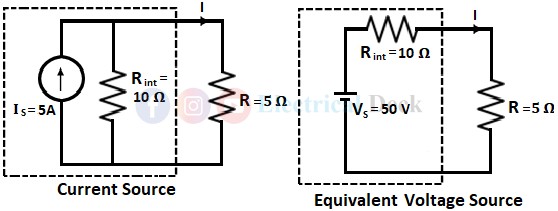Source transformation is a technique used in analyzing complex electrical circuits. The source transformation method simplifies the circuit by transforming a voltage source into an equivalent current source and similarly a current source into an equivalent voltage source.
Before going to the source transformation technique let us first understand what is a practical voltage source and current source.
Practical Voltage Source :
An ideal voltage source is one whose terminal voltage remains constant at every instant no matter how much current flow through it. But in reality, we do not have any ideal voltage sources. A real or practical voltage source has some internal resistance which causes internal voltage drop when current flow through it.
Hence the terminal voltage of a practical voltage source will no longer remain constant but rather decreases with an increase in current through it and vice-versa. Thus an ideal voltage source is a theoretical concept that is independent of current, while a practical voltage source is a real-world device whose output voltage depends on current.
A practical voltage source is represented by an ideal voltage source with a series internal resistance as shown above. Some examples of voltage sources are batteries, dc generators, alternators, etc.
Practical Current Source :
An ideal current source delivers constant current irrespective of the load connected to it. But it is not possible to have an ideal current source in the real world. A practical current source shows dependency on the voltage across it due to the presents of some internal resistance that causes some drop in current.
Thus the current delivered by a practical current source will no longer remain constant rather it decreases with an increase in voltage across it. A practical current source is modeled as the ideal current source with a parallel internal resistance as shown above.
Above we have seen about practical voltage source and current source. Now let us see how a real voltage source is converted into an equivalent current source and a current source is converted into an equivalent voltage source.
Voltage Source to Current Source Conversion :
First, let us see the conversion of a practical voltage source to a practical current source. We know that a practical voltage source is represented by an ideal voltage source Vs in series with a resistance whose value is equal to its internal resistance Rint as shown in the below figure.
In the above practical voltage source, the load current IL is given by,
Where,- Vs = Voltage of voltage source,
- Rint = Internal resistance of voltage source,
- RL = Load resistance connected to the voltage source.
Now let us consider the equivalent circuit of the practical current source shown above. The load current IL is given by,
Where,- Is = Current of the current source,
- Rint = Internal resistance of current source,
- RL = Load resistance connected to the current source.
The two sources become identical when we equate equations 1 and 2,
Thus, a practical voltage source is equivalent to a current source of current I = V/Rint and internal resistance Rint in parallel with the current source. The value of the parallel internal resistance of the equivalent current source will be equal to the internal resistance of the original voltage source.
Example :
A voltage source of 12V with an internal resistance of 0.5Ω is connected to a 1.5Ω resistor. The current in the resistor is,
Converting the voltage source into an equivalent current source, the value of the current source will be,
The current in resistance R will be,
Current Source to Voltage Source Conversion :
Now let us see the conversion of a practical current source into an equivalent voltage source. The below shows the representation of a practical current source which will be an ideal current source in parallel with internal resistance.
In the above practical current source, the load current IL is given by,
Where,- Is = Current of the current source,
- Rint = Internal resistance of current source,
- RL = Load resistance connected to the current source.
Now referring to the equivalent practical voltage source shown above. The load current IL is given by,
Where,- Vs = Voltage of voltage source,
- Rint = Internal resistance of voltage source,
- RL = Load resistance connected to the voltage source.
By equating equation 3 and equation 4, we get,
From the above equation, it is clear that a current source is converted into an equivalent voltage source of voltage V = I Rint and internal resistance Rint in series with the voltage source. The value of series internal resistance Rint of the equivalent voltage source will be equal to the parallel resistance of the original current source.
Example :
A current source of 5A having an internal resistance of 10Ω is connected to a load resistor of 5Ω. The current in the load resistor using source transformation is,
Converting the current source into an equivalent voltage source, the value of the voltage source will be,
The current in load resistance R will be,
Therefore, a voltage source is converted into an equivalent current source and a current source is converted into an equivalent voltage source. A voltage source is a dual of a current source and a current source is a dual of a voltage source.
Source transformation simplifies the analysis of the circuit. Any resistance whether it can be internal or external in series with the voltage source can be considered while converting to an equivalent current source. Similarly, any resistance in parallel with the current source can be converted to an equivalent voltage source.












